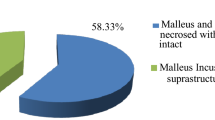Abstract
Purpose
This study aimed to investigate the rate and location of facial canal dehiscence (FCD) observed during surgery for chronic otitis media (COM) with or without cholesteatoma.
Material and method
Operative details of 1296 patients who underwent chronic otitis media surgery from January 2000 to January 2017 by the same surgeon were included in this retrospective study focusing on intraoperative observations of FCD.
Results
Because of the type of the surgery, the Fallopian canal could not be seen completely, so 924 of the cases which only involved performing a tympanoplasty were not included in the study. A total of 372 patients (196 males and 176 females) who had a canal wall down (CWD) or canal wall up (CWU) mastoidectomy were included in the study. A CWD mastoidectomy was performed on 250 patients, while 122 patients underwent a CWU mastoidectomy. The prevalence of FCD was 11.29% (42/372 patients). The dehiscence was more common in patients with cholesteatoma (n = 37; 88.1%) than those with non-cholesteatoma (n = 5; 11.9%). The tympanic segment (n = 32; 76.19%) was the most common location for FCD. When we compared the ossicular erosion results of the cases that had FCD, erosion in three ossicles together was more statistically significantly frequent than the other possibilities.
Conclusion
It is possible to see FCD because of COM, especially with cholesteatoma. FCD is most commonly seen around the oval window. If stapes or all three ossicles are eroded, the surgeons must be more careful regarding FCD to be more effective in preventing facial nerve damage.
Similar content being viewed by others
References
Nomiya S, Kariya S, Nomiya R, Morita N, Nishizaki K, Paparella MM, Cureoglu S (2014) Facial nerve canal dehiscence in chronic otitis media without cholesteatoma. Eur Arch Otorhinolaryngol 271(3):455–458. https://doi.org/10.1007/s00405-013-2431-2
Di Martino E, Sellhaus B, Haensel J, Schlegel JG, Westhofen M, Prescher A (2005) Fallopian canal dehiscences: a survey of clinical and anatomical findings. Eur Arch Otorhinolaryngol 262(2):120–126
Uno Y, Saito R (1995) Bone resorption in human cholesteatoma: morphological study with scanning electron microscopy. Ann Otol Rhinol Laryngol 104(6):463–468
Moreano EH, Paparella MM, Zelterman D, Goycoolea MV (1994) Prevalence of facial canal dehiscence and of persistent stapedial artery in the human middle ear: a report of 1000 temporal bones. Laryngoscope 104(3 Pt 1):309–320
Baxter A (1971) Dehiscence of the Fallopian canal. An anatomical study. J Laryngol Otol 85(6):587–594
Selesnick SH, Lynn-Macrae AG (2001) The incidence of facial nerve dehiscence at surgery for cholesteatoma. Otol Neurotol 22(2):129–132
Welling DB, Glasscock ME III, Gantz BJ (1992) Avulsion of the anomalous facial nerve at stapedectomy. Laryngoscope 102(7):729–733
Sheehy JL, Brackmann DE, Graham MD (1977) Cholesteatoma surgery: residual and recurrent disease. A review of 1,024 cases. Ann Otol Rhinol Laryngol 86(4 Pt 1):451–462
Harvey SA, Fox MC (1999) Relevant issues in revision canal-wall-down mastoidectomy. Otolaryngol Head Neck Surg 121(1):18–22
Moody MW, Lambert PR (2007) Incidence of dehiscence of the facial nerve in 416 cases of cholesteatoma. Otol Neurotol 28(3):400–404
Ozbek C, Tuna E, Ciftci O, Yazkan O, Ozdem C (2009) Incidence of fallopian canal dehiscence at surgery for chronic otitis media. Eur Arch Otorhinolaryngol 266(3):357–362. https://doi.org/10.1007/s00405-008-0748-z
Perez B, Campos ME, Rivero J, Lopez Campos D, López-Aguado D (1997) Incidence of dehiscences in the fallopian canal. Int J Pediatr Otorhinolaryngol 40(1):51–60
Dornelles Cd C, da Costs SS, Meurer L, Rosito LP, da Silva AR, Alves SL (2009) Comprasion of acquired cholesteatoma between pediatric and adult patients. Eur Arch Otorhinolaryngol 266(10):1553–1561. https://doi.org/10.1007/s00405-009-0957-0. (Epub 2009 Mar 26)
Chan K, Wang P, Chen Y, Wu C (2011) Facial nerve dehiscence at mastoidectomy for cholesteatoma. J Int Adv Otol 7:311–316
Kozerska M, Skrzat J, Spulber A, Walocha J, Wroński S, Tarasiuk J (2017) Micro-CT study of the dehiscences of the tympanic segment of the facial canal. Surg Radiol Anat 39(4):375–382. https://doi.org/10.1007/s00276-016-1744-4
Acknowledgements
We thank to SY for his help on statistical evaluations of the data. We thank to Prof. HA for her revision on statistical analysis.
Funding
They have no funding to disclose.
Author information
Authors and Affiliations
Corresponding author
Ethics declarations
This study was retrospectively data analysis study and it did not need to informed consent. This retrospective study was performed after approval of local ethic committee.
Conflict of interest
The authors declare that they have no conflict of interest.
Human and animal rights statement
The study has been approved by the Ethical Committee of the University Hospital and has been performed according to the ethical standards of the Helsinki Declaration. Because of it was a retrospective study, formal consent was not required. We declare that all authors have contributed to, read and approved the final manuscript for submission.
Rights and permissions
About this article
Cite this article
Kalcioglu, M.T., Kilic, O., Tuysuz, O. et al. Facial canal dehiscence rate: a retrospective analysis of 372 chronic otitis media cases. Eur Arch Otorhinolaryngol 276, 79–83 (2019). https://doi.org/10.1007/s00405-018-5198-7
Received:
Accepted:
Published:
Issue Date:
DOI: https://doi.org/10.1007/s00405-018-5198-7



